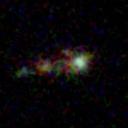 According to research presented by Eric Gawiser of Rutgers University, ancestors of Milky Way (MW) like galaxies appear to be Lyman Alpha emitting galaxies. These progenitors were about 1/10th the size of the MW, 1/20th the mass of the MW, and 1/40th the stellar mass of the MW (the rest of the mass is gas and dust – the stars are still forming). (image left of Lyman Alpha galaxy, credit: NASA, ESA, Caryl Gronwall/Penn State)
According to research presented by Eric Gawiser of Rutgers University, ancestors of Milky Way (MW) like galaxies appear to be Lyman Alpha emitting galaxies. These progenitors were about 1/10th the size of the MW, 1/20th the mass of the MW, and 1/40th the stellar mass of the MW (the rest of the mass is gas and dust – the stars are still forming). (image left of Lyman Alpha galaxy, credit: NASA, ESA, Caryl Gronwall/Penn State)
This research used the CTIO 4-m telescope to image optical and find lyman alpha emitting blobs (that are red shifted to visual), Spitzer IR images, Magellan 6.5m telescope spectra to get distances (and thus time the light was emitted), and HST ACS to determine sizes using hi resolution images.
These objects had already formed by 2 billion years after the big bang. Through mergers they built galaxies larger and larger systems until today those once many small systems have combined into a few small systems. This is an ongoing process (that is slowing), with small galaxies continuing to form, and merge, and build new systems.
This is a previously suspected idea (there are just so many things out there that can form galaxies!), and it’s good to see the list of possible things get narrowed down to at least 1 certain culprit (it may have had accomplices).
It should be noted, this only applies to Milky Way sized systems. Elizabeth McGrath of UC Santa Cruz points out in another new discovery that the biggest galaxies actually formed via gas collapse. Rather then waiting for a bunch of little systems to form and combine, these systems just collapsed very rapidly while forming stars


